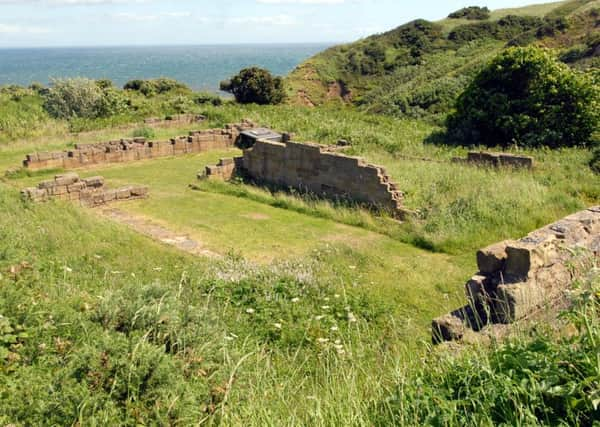Your Day Out: Scenic route down to Bay


This walk is easily accessed by bus or private transport, starting from The Raven Hall Hotel, Ravenscar, and is certainly one of the most scenic routes of all.
From the Raven Hall Hotel descend Peakside beside the National Trust Visitor Centre. On Peakside observe the bricks used to surface the roadway, with ‘Ravenscar’ printed on them, locally produced at Whitaker’s Brickworks. Rejoining the trackbed, the route begins to descend through a large alum quarry, which was also the site of the brickworks, having a railway siding until the 1930s. It’s interesting to learn that bricks from Whitaker’s were used to build the Northstead Housing Estate in Scarborough, and the former Odeon Cinema which is now the Stephen Joseph Theatre.
Advertisement
Hide AdAdvertisement
Hide AdAfter the quarry, the route skirts magnificent heather-clad hillsides, the scene of those disastrous fires in 2003 you may recall. Admire magnificent views across Robin Hood’s Bay. Continue the descent through woodland, and cross several deep valleys on large embankments, before the site of Fyling Hall station is reached. As a bridge has been removed, this necessitates a descent to the lane before climbing back up to track level.
The old station platform is easily overlooked among the trees. However, as you pass Middlewood Farm caravan site, and the backs of a row of fine houses in Fylingthorpe village, the views soon return.
At Lingers Corner, another road crossing is made, before arriving at the former Robin Hood’s Bay station. The station buildings have been converted into other uses. The village’s main car park has been built over the station yard. There are various cafes and public houses in this popular village. However, the main street down to the rocky beach is very steep.
The station at Robin Hood’s Bay was the main intermediate station between Scarborough and Whitby, with a passing loop, water tower and extensive goods sidings. It was also the location of several ‘Camping Coaches’. These railway carriages were used as holiday homes. These were very popular for family holidays right up until the closure of the line.
Advertisement
Hide AdAdvertisement
Hide AdNow I suggest you explore the area, or enjoy welcome refreshment in one of the many cafes, restaurants or inns.
For a real insight into Robin Hood’s Bay, the descent to the beach is highly recommended, along the old coastguard station, quaint shops, and cobbled alleyways between cottages and colourful floral displays.
Enjoy your day out, and don’t miss the final leg of the line from Robin Hood’s Bay to Whitby!
l Ravenscar’s Alum Works
Alum mines first brought industry to this area. It was at Ravenscar that the National Trust discovered and preserved remnants of the Peak Alum Works that operated between 1650 to the late 1800s. Walking along the disused rail track below Ravenscar’s quarries reveals little to indicate its ancient site of a chemical industry.
Advertisement
Hide AdAdvertisement
Hide AdAlum is a complex mineral discovered in the Jurassic rocks. This mineral was a mixture of the sulphates of aluminium, potassium and ammonia that originally was used largely in the textile industry to fix dyes, and also in tanning, as well as in the manufacture of parchment and candles.
Raw materials were mostly from the Ravenscar area. Shale was easy to ‘mine’. Ash was produced from burnt seaweed, providing soda and potash. Ammonia was obtained from human urine, stored in pails and collected in a couple of 25 gallon barrels strapped each side of a horse. It provided an essential alkali. Over 100 tons of shale were needed to produce one ton of alum.
Mounds of shale on brushwood furze were up to 33 metres in height. Shale was slowly roasted over a wood fire. It would burn and stink for nine or twelve months. The mound was then steeped in water to dissolve out mineral salts. The solution was boiled out in huge pans. The concentrated liquid was poured into tanks, settled and then was pumped out. Potash from seaweed was added and the cooled liquor had urine added, producing an obnoxious smell.
The mixture was boiled every five days and left to ‘stew’ until it turned into colourless alum crystals. These were re-dissolved in clear water so that a second crystallisation would produce pure alum. At the Peak Alum Works huge grinding stones pounded the alum crystals into alum flour. Its uses were many. Can you find 10 uses for this product?
Distance: Five miles (one way only - return by bus).
Advertisement
Hide AdAdvertisement
Hide AdRefreshment: Raven Hall Hotel and Natural Trust Visitor Centre, Ravenscar; cafes, restaurants and inns at Robin Hood’s Bay.
Transport: Private transport or bus service 115 to Ravenscar and Arriva X93 from Robin Hood’s Bay return.